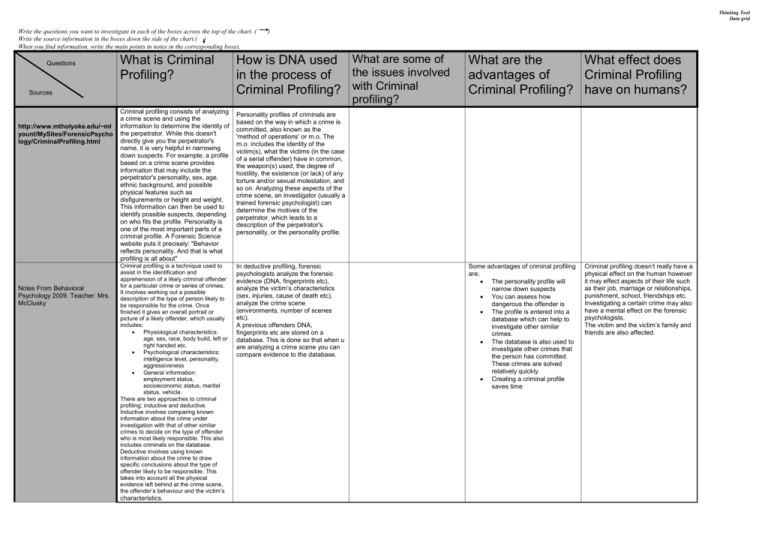Write the questions you want to investigate in each of the boxes
advertisement

Thinking Tool Data grid Write the questions you want to investigate in each of the boxes across the top of the chart. ( Write the source information in the boxes down the side of the chart.( ) When you find information, write the main points in notes in the corresponding boxes. Questions What is Criminal Profiling? Sources http://www.mtholyoke.edu/~ml yount/MySites/ForensicPsycho logy/CriminalProfiling.html Notes From Behavioral Psychology 2009. Teacher: Mrs. McClusky ) How is DNA used What are some of the issues involved in the process of Criminal Profiling? with Criminal profiling? Criminal profiling consists of analyzing a crime scene and using the information to determine the identity of the perpetrator. While this doesn't directly give you the perpetrator's name, it is very helpful in narrowing down suspects. For example, a profile based on a crime scene provides information that may include the perpetrator's personality, sex, age, ethnic background, and possible physical features such as disfigurements or height and weight. This information can then be used to identify possible suspects, depending on who fits the profile. Personality is one of the most important parts of a criminal profile. A Forensic Science website puts it precisely: "Behavior reflects personality. And that is what profiling is all about" Criminal profiling is a technique used to assist in the identification and apprehension of a likely criminal offender for a particular crime or series of crimes. It involves working out a possible description of the type of person likely to be responsible for the crime. Once finished it gives an overall portrait or picture of a likely offender, which usually includes; Physiological characteristics: age, sex, race, body build, left or right handed etc. Psychological characteristics: intelligence level, personality, aggressiveness General information: employment status, socioeconomic status, marital status, vehicle. There are two approaches to criminal profiling; inductive and deductive. Inductive involves comparing known information about the crime under investigation with that of other similar crimes to decide on the type of offender who is most likely responsible. This also includes criminals on the database. Deductive involves using known information about the crime to draw specific conclusions about the type of offender likely to be responsible. This takes into account all the physical evidence left behind at the crime scene, the offender’s behaviour and the victim’s characteristics. What are the What effect does advantages of Criminal Profiling Criminal Profiling? have on humans? Personality profiles of criminals are based on the way in which a crime is committed, also known as the 'method of operations' or m.o. The m.o. includes the identity of the victim(s), what the victims (in the case of a serial offender) have in common, the weapon(s) used, the degree of hostility, the existence (or lack) of any torture and/or sexual molestation, and so on. Analyzing these aspects of the crime scene, an investigator (usually a trained forensic psychologist) can determine the motives of the perpetrator, which leads to a description of the perpetrator's personality, or the personality profile. In deductive profiling, forensic psychologists analyze the forensic evidence (DNA, fingerprints etc), analyze the victim’s characteristics (sex, injuries, cause of death etc), analyze the crime scene (environments, number of scenes etc). A previous offenders DNA, fingerprints etc are stored on a database. This is done so that when u are analyzing a crime scene you can compare evidence to the database. Some advantages of criminal profiling are; The personality profile will narrow down suspects You can assess how dangerous the offender is The profile is entered into a database which can help to investigate other similar crimes. The database is also used to investigate other crimes that the person has committed. These crimes are solved relatively quickly. Creating a criminal profile saves time Criminal profiling doesn’t really have a physical effect on the human however it may effect aspects of their life such as their job, marriage or relationships, punishment, school, friendships etc. Investigating a certain crime may also have a mental effect on the forensic psychologists. The victim and the victim’s family and friends are also affected. Thinking Tool Data grid http://www.stephpalmer.co.uk/Cri minal/inductive%20and%20dedu ctive%20profiling.doc The advantages of the Inductive Criminal Profiling model are readily apparent. Foremost is that Inductive Profiling is a very easy tool to use, for which no specialized forensic knowledge, education, or training in the study of criminal behaviour or criminal investigation is required. Additionally, general profiles can be assembled in a relatively short period of time without any great effort or ability on the part of the profiler. The result is often a one or two page list of unqualified characteristics. These generalizations can accurately predict some of the non-distinguishing elements of individual criminal behaviour, but not with a great deal of consistency or reliability. Deductive Criminal Profiling is also useful for thoroughly establishing Modus Operandi behaviour, as well as offender signature behaviour, which assists in the linkage of seemingly unrelated crimes. According to Geberth, the Modus Operandi, or MO behaviour, or method of operation, is a dynamic, learned behaviour, changing over time, as the offender becomes more experienced. It involves only those actions that are necessary to commit the offense. Another very tangible advantage of the Deductive Criminal Profiling method is that, because it so thoroughly explores victimology, and the nature of the interaction between the victim(s), the crime scene(s), and the offender, it can very pointedly demonstrate an individual offender's motivations in even the most bizarre or seemingly senseless offenses. The final major advantage of the Deductive Criminal Profiling method is that it examines behaviours of individual offenders as they occur over time. Change and growth are allowed for, analyzed, and recompiled back into the criminal profile. As something like offender MO behaviour or motivations change or evolve over the course of multiple offences in an offender's career, it is noticed and it used to better understand the offender. Thinking Tool Data grid http://www.crimtrac.gov.au/pri vacy/index.html As a Commonwealth agency, CrimTrac must operate in accordance with the Commonwealth Privacy Act 1988. Section 14 of the Privacy Act specifies eleven Information Privacy Principles (IPPs) that govern how agencies may collect, store, use and disclose personal information What is personal information? The Privacy Act defines personal information as: "information or an opinion (including information or an opinion forming part of a database), whether true or not, and whether recorded in a material form or not, about an individual whose identity is apparent, or can reasonably be ascertained, from the information or opinion". CrimTrac operational systems contain personal information (e.g. fingerprints, criminal histories, firearms registrations etc). The role of CrimTrac The primary role of CrimTrac is to provide Australia's police services with enhanced access to high quality operational information, much of which is personal information. In performing this role, CrimTrac acts as an information clearing house for the police services. The CrimTrac Agency does not collect personal information from individuals. Rather, it undertakes what are referred to as 'third party collections' from police services, which may in turn have collected the information directly from the individuals concerned. When information is provided through the CrimTrac Agency to the police it is for the purpose of criminal investigation and law enforcement. The privacy regime for personal information The CrimTrac Agency is required to ensure that personal information within its possession or control is handled in accordance with the IPPs. Amongst other things, the agency is required, along with its contractors to: ensure the safe storage and security of information within CrimTrac (IPP 4); provide details of the nature of personal information held within CrimTrac in an annual report to the Commonwealth Privacy Commissioner (IPP 5) Thinking Tool Data grid where relevant, provide individuals with access to their personal information held within CrimTrac (IPP 6); where relevant, allow for the updating of personal information held within CrimTrac (IPP 7); limit use and disclosure of personal information (IPPs 10 & 11); and generally assist in the promotion and implementation of privacy safeguards. To meet its privacy obligations, CrimTrac: is actively involving the Commonwealth Privacy Commissioner in the development of its information privacy policies and procedures, including the role of the Commissioner in auditing its activities; has put in place stringent security measures to protect the security of the personal information in its systems and to guard against unauthorised access, use, modification or disclosure. CrimTrac's systems use sophisticated hardware, software and communications technology to combat attempted unauthorised access or interference with data. Access to operational data is on a need to know basis, and audit logs are maintained of who has accessed what information; includes privacy requirements in its contracts with outsourced service providers; provides privacy training to its staff and contractors so that they are aware of their obligations; is working with police services to reinforce best practice in how information on operational systems is accessed; and is developing policies for Thinking Tool Data grid handling requests to access personal information and complaints. Good privacy is good policing There is a convergence between the interests of Australian police services and adherence to the IPPs. Police services need to be confident that: SUMMARY Criminal profiling is used to narrow down suspects. Creating a criminal profile will give you certain characteristics to look for in a suspects for example physical, psychological, social characteristics. There are two approaches to criminal profiling’ inductive and deductive. Inductive criminal profiling involves comparing known information about the crime under investigation with that of similar crimes, to decide on the type of offender who is most likely to be responsible. Deductive criminal profiling involves using known information about the crime its self to draw specific conclusions about the type of offender who is likely to be responsible. Whilst investigating a crime, forensic psychologists and scientists will collect evidence from the crime scene. This evidence helps to check the profile after apprehension. This evidence is then entered onto a database where it can be used in analyzing other crimes. the information held on CrimTrac systems is secure and not open to unauthorised access, use or tampering; the information that they are accessing is accurate and up to date; their officers are using the information provided through the CrimTrac Agency for the purpose of law enforcement; and the systems, policies and procedures that the CrimTrac Agency is implementing will assist in achieving the twin goals of personal information privacy and good policing. Obviously privacy is one of the biggest issues in criminal profiling and databases. This issue has been solved by introducing the Commonwealth Privacy Act 1988 and in particular the Information Privacy Principles more commonly known as the IPP’s. The 1988 Privacy Act defines personal information as "information or an opinion (including information or an opinion forming part of a database), whether true or not, and whether recorded in a material form or not, about an individual whose identity is apparent, or can reasonably be ascertained, from the information or opinion." Commonwealth agencies are required to ensure that personal information within its possession or control is handled in accordance with the IPPs. Amongst other things, the agency is required, along with its contractors to: ensure the safe storage and security of information within CrimTrac (IPP 4); provide details of the nature of personal information held within CrimTrac in an annual report to the Commonwealth Privacy Commissioner (IPP 5) where relevant, provide individuals with access to their personal information held within CrimTrac (IPP 6); where relevant, allow for the updating of personal information held within CrimTrac (IPP 7); Saves time Easy to use (inductive) Gives an accurate prediction to who is responsible for the crime Examines behaviours of criminals that change over time Helps to understand victimology. The personality profile will narrow down suspects You can assess how dangerous the offender is The profile is entered into a database which can help to investigate other similar crimes. The database is also used to investigate other crimes that the person has committed. These crimes are solved relatively quickly. Criminal profiling doesn’t really have a physical effect on the human however it may effect aspects of their life such as their job, marriage or relationships, punishment, school, friendships etc. Investigating a certain crime may also have a mental effect on the forensic psychologists. The victim and the victim’s family and friends are also affected. Thinking Tool Data grid limit use and disclosure of personal information (IPPs 10 & 11); and generally assist in the promotion and implementation of privacy safeguards. Agencies must also need to be confident that: the information held on CrimTrac systems is secure and not open to unauthorised access, use or tampering; the information that they are accessing is accurate and up to date; their officers are using the information provided through the CrimTrac Agency for the purpose of law enforcement; and the systems, policies and procedures that the CrimTrac Agency is implementing will assist in achieving the twin goals of personal information privacy and good policing.








